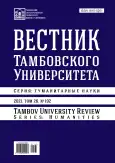British Air Force slang. Influence of the First World War
- Authors: Mitchell P.J.1, Andrakhanov A.A.1, Trusov E.V.1
-
Affiliations:
- National Research Tomsk State University
- Issue: Vol 26, No 192 (2021)
- Pages: 16-23
- Section: THEORY AND METHODS OF FOREIGN LANGUAGE TEACHING
- URL: https://ogarev-online.ru/1810-0201/article/view/298381
- DOI: https://doi.org/10.20310/1810-0201-2021-26-192-16-23
- ID: 298381
Cite item
Full Text
Abstract
World War One had an impact not only the development of international relations throughout the 20th century, but also led to the creation of air forces of different countries. More than 30 countries participated in the First World War. The British Empire, which fought on the side of the Entente, was one of them. During the First World War, the importance of the Air Force increased. It played a decisive role in gaining dominance amidst the aerospace. Aviation, which tasks included aerial reconnaissance and bomb attacks, evolved significantly. A huge number of new experimental military equipment have appeared. All of this produced a huge number of military slang terms. In this study, we will examine the slang terms that appeared in the slang of the British Air Force during the First World War, classify them and make a conclusion about the influence of the First World War on the development of military slang terms. During the training of specialists in the linguistic support of military activity, the topic of military slang remains understudied, which is why interpreters have difficulties in translating slang units. Therefore, the studying of this phenomenon can improve the skills of military interpreters and allow them to avoid major mistakes in their professional activity.
About the authors
P. J. Mitchell
National Research Tomsk State University
Email: peter_mitchell@mail.ru
ORCID iD: 0000-0001-9228-903X
Doctor of Education, Professor, Head of Translation and Language Communications Department, Head of the International Master’s Degree Programme “Global MA in ELT Leadership”
36 Lenin St., Tomsk 634050, Russian FederationA. A. Andrakhanov
National Research Tomsk State University
Email: andrashanov@mail.ru
ORCID iD: 0000-0001-5537-7129
Assistant of Translation and Language Communications Department
36 Lenin St., Tomsk 634050, Russian FederationE. V. Trusov
National Research Tomsk State University
Author for correspondence.
Email: egor.trusov.2000@mail.ru
ORCID iD: 0000-0002-3688-3701
Assistant of Translation and Language Communications Department
36 Lenin St., Tomsk 634050, Russian FederationReferences
- Mitchell P.J. Angliyskiy voyennyy sleng: ponyatiye, sposoby obrazovaniya i tematicheskaya klassifikatsiya [English military slang: definition, means of formation and thematic classification]. Yazyk i kul’tura – Language and Culture, 2014, no. 3, pp. 64-73. (In Russian).
- Belova I.V., Pavlova Y.E. Leksiko-semanticheskiye osobennosti voyennogo slenga v amerikanskom variante angliyskogo yazyka [Lexical and semantic features of military slang in American English]. Vestnik Yuzhno-Ural’skogo gosudarstvennogo universiteta. Seriya: Lingvistika [Bulletin of South Ural State University, Series “Linguistics”], 2008, no. 1 (101), pp. 33-38. (In Russian).
- Korovushkin V.P. Vvedeniye v izucheniye angloyazychnogo voyennogo zhargona. Ch. 1. Teoreticheskiye osnovy i problematika sotsiolekticheskogo opisaniya [Introduction to Learning English Military Parlance. Pt 1. Theoretical Basis and Problematics of Sociolect Description]. Cherepovets, Cherepovets Higher Military Engineering Institution of Radiotronics Publ., 1989. (In Russian).
- Korovushkin V.P. Vvedeniye v izucheniye angloyazychnogo voyennogo zhargona. Ch. 2. Obshcheprostorech-nyye kharakteristiki voyennykh zhargonizmov (opyt sotsiolekticheskogo opisaniya) [Introduction to Learning English Military Parlance. Pt 2. General Characteristics of Military Parlance (Experience of Sociolect Descrip-tion)]. Cherepovets, Cherepovets Higher Military Engineering Institution of Radiotronics Publ., 1989. (In Rus-sian).
- Korovushkin V.P. Vvedeniye v izucheniye angloyazychnogo voyennogo zhargona. Ch. 3. Spetsificheskiye kha-rakteristiki voyennykh zhargonizmov (opyt sotsiolekticheskogo opisaniya) [Introduction to Learning English Military Parlance. Pt 3. Specific Characteristics of Military Parlance (Experience of Sociolect Description)]. Cherepovets, Cherepovets Higher Military Engineering Institution of Radiotronics Publ., 1989. (In Russian).
- Partridge E. A Dictionary of RAF Slang. Michael Joseph Limited Publ., 1945.
- Pegler M. Soldiers’ Songs and Slang of the Great War. Oxford, Osprey, 2014.
- Smith L.N. Lingo of No Man’s Land. London, The British Library Publ., 2014, 112 p.
Supplementary files









